#the scientific nature of natural disasters
Explore tagged Tumblr posts
Text
At the direction of the Trump administration, the federal Department of Health and Human Services and its agencies are purging its websites of information and data on a broad array of topics — from adolescent health to LGBTQ+ rights to HIV.
Several webpages from Centers for Disease Control and Prevention with references to LGBTQ+ health were no longer available. A page from the HHS Office for Civil Rights outlining the rights of LGBTQ+ people in health care settings was also gone as of Friday. The website of the National Institutes of Health’s Office for Sexual & Gender Minority Research Office disappeared. (Most of these pages could still be viewed through the Internet Archive.)
The changes at the CDC and NIH are examples of a broad push by the Trump administration on gender issues under an executive order titled "Defending Women from Gender Ideology Extremism and Restoring Biological Truth to the Federal Government." That order directs agencies throughout the government to stop offering "gender identity" as a choice on government forms and to end funding of “gender ideology.”
Another order, signed by Trump, takes aim at “diversity, equity, and inclusion” across the federal government.
On Friday, however, many pages that did not seem related to “gender” or “diversity” had also been taken down, such as AtlasPlus, an interactive tool from CDC with surveillance data on HIV, viral hepatitis, STDs and TB. Also gone missing: a page with basic information about HIV testing. The CDC’s Social Vulnerability Index, a tool that assesses community resilience in the event of natural disaster was also taken down.
“The removal of HIV- and LGBTQ-related resources from the websites of the Centers for Disease Control and Prevention and other health agencies is deeply concerning and creates a dangerous gap in scientific information and data to monitor and respond to disease outbreaks," the Infectious Disease Society of America said in a statement. "Access to this information is crucial for infectious diseases and HIV health care professionals who care for people with HIV and members of the LGBTQ community and is critical to efforts to end the HIV epidemic. This is especially important as diseases such as HIV, mpox, sexually transmitted infections and other illnesses threaten public health and impact the entire population."
What the fuck is going on.
44 notes
·
View notes
Text
At the direction of the Trump administration, the federal Department of Health and Human Services and its agencies are purging its websites of information and data on a broad array of topics — from adolescent health to LGBTQ+ rights to HIV.
Several webpages from Centers for Disease Control and Prevention with references to LGBTQ+ health were no longer available. A page from the HHS Office for Civil Rights outlining the rights of LGBTQ+ people in health care settings was also gone as of Friday. The website of the National Institutes of Health's Office for Sexual & Gender Minority Research Office disappeared. (Most of these pages could still be viewed through the Internet Archive.)
The changes at the CDC and NIH are examples of a broad push by the Trump administration on gender issues under an executive order titled "Defending Women from Gender Ideology Extremism and Restoring Biological Truth to the Federal Government." That order directs agencies throughout the government to stop offering "gender identity" as a choice on government forms and to end funding of "gender ideology."
Another order, signed by Trump, takes aim at "diversity, equity, and inclusion" across the federal government.
On Friday, however, many pages that did not seem related to "gender" or "diversity" had also been taken down, such as AtlasPlus, an interactive tool from CDC with surveillance data on HIV, viral hepatitis, STDs and TB. Also gone missing: a page with basic information about HIV testing. The CDC's Social Vulnerability Index, a tool that assesses community resilience in the event of natural disaster was also taken down.
"The removal of HIV- and LGBTQ-related resources from the websites of the Centers for Disease Control and Prevention and other health agencies is deeply concerning and creates a dangerous gap in scientific information and data to monitor and respond to disease outbreaks," the Infectious Disease Society of America said in a statement. "Access to this information is crucial for infectious diseases and HIV health care professionals who care for people with HIV and members of the LGBTQ community and is critical to efforts to end the HIV epidemic."
Data on adolescent health missing
One striking example of the vanishing information: The CDC pulled down the website that houses data collected by the nation's largest monitoring program on health-related behaviors among high schoolers.
Pages related to the CDC's Division of Adolescent and School Health, which administers the program, were also unavailable.
The Youth Risk Behavior Surveillance System tracks key metrics on nutrition, physical activity, tobacco and drug use, sexual behavior and other areas. The program was created 35 years ago and includes a national survey that researchers rely on to measure how behaviors influence health and design prevention measures.
"It's the way the nation understands adolescent health," says Stephen Russell, a sociologist at the University of Texas at Austin who studies adolescent health. "The disappearance of that data is stunning."
21 notes
·
View notes
Note
Hi it’s the Kaz/Alina/Darkling anon! I don’t really have anything specific in mind there’s so little for the ship that I’m down for anything lol. But I wouldn’t mind another soulmate au☺️
hi there! sorry this took so long, but i finally decided how to write a sequel to this fic so have a peek! (in case you have not read the first fic, it is here, but basically kaz, alina, and the darkling are soulmates. that's the important info haha)
“We should kill them all,” Alina says conversationally, nails gripping the wood of the makeshift War Table, when the council of Grisha cannot agree on the amount of ships that will sail to retrieve their third. Some suggest masking it as a small expedition. Others, a full out armada, prepared for battle.
The tent is hot. Alina knows that it is because of her. Can feel the sun roiling underneath her skin.
“Pekka Rollins is the problem,” Inej is saying as Alina consciously takes her nails out of the table, twirling her knife in her fingers. Inej is the only non-Grisha in the tent, and yet, the entire war council weighs each word of hers carefully. “We can send a small group in to extract Kaz and be out, no one the wiser.”
“Ketterdam is the problem,” Alina hisses. “If they do not present my soulmate to me at the docks of their loathsome city, regardless of who took him, I will sink it.”
Many people in the tent gape at Alina, who is normally the one talking their General down from similar action. “You are suggesting war-” Zoya begins.
“I am suggesting annihilation,” Alina corrects. “War implies that they would have the ability to fight back.”
“Even if we end the city,” Ivan says, “and I am not against it, we still need to find Mr. Brekker first.”
“I can find him,” Inej says confidently.
“Ketterdam will find him,” Alina argues, and the room begins to heat to unbearable temperatures, “when they see Ravka’s forces, with the Darkling and I at the helm, crossing the sea. They will find him if they want to live.”
“You are too emotional,” Aleksander says, the first thing he has said in a long time. and the tent is so silent that one could hear a pin drop. Sweat drips from Inej's brow.
Alina opens her mouth to scream, raises her hands to choke him or burn him or something similarly painful, just to release what is building inside of her.
“You are not wrong, Alina, but you need to calm yourself. The sun is leaking from you,” he elaborates, and she bares her teeth at him. “I have a solution.”
He grasps her by the wrist before she can Cut him, yanks her after him out of the tent, into the woods.
She readies herself for a fight. He throws her against a tree, and, and,
Takes her mouth with his.
It’s not a kiss. Something so brutal, so angry, so primal, cannot be called a kiss. She draws blood from his lips, from his back where she tears his clothes from his body and into his skin. He draws bruises down her neck and along her back where he shoves her against the bark of the tree.
He fights her down into the grass and dirt, and she burns. A thin layer of shadow protects him from the worst of it, but he still feels hot to the touch. He is never hot to the touch.
When she comes, she presses her power down, not up. She wants to hurt him, but she does not want to destroy him.
He does the same, pressing his shadows down into the ground around her, a perfect cut out of her body underneath his. She dreams about that kind of control.
When they come to, it is on a tiny island of dirt. In the middle of a crater, maybe fifty feet in any direction. He helps her to her feet, and they climb down and up, back to camp.
“We will find him,” Alina says. Or I will burn it all down, she doesn’t say. But it does not go unheard.
“We will bring him home,” Aleksander agrees. Or no mortal will survive my wrath, is left unsaid. Alina, too, hears it all the same.
There are no saints in the clearing. Leaving a crater of their own making, hand in hand in destruction, are two gods.
#darklina#kaz x darkling x alina#alina starkov#kazalina#the darkling#kaz brekker#aleksander morozova#what are ship names#my writing#answered#anonymous#this is gonna be a whole thing just wait#alina is like poseidon's job doesn't sound too hard#how does the sun drown a city?#stay tuned#it's getting real when i have to start googling#the scientific nature of natural disasters
2 notes
·
View notes
Text
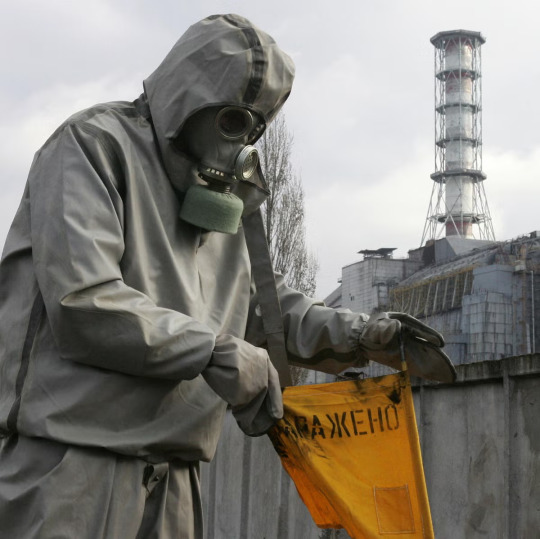


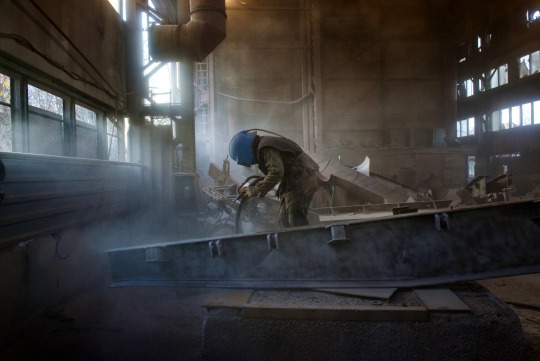
Inside the Chernobyl Exclusion Zone, scientists have discovered a black fungus capable of feeding on deadly gamma radiation.
Scientists believe this mechanism could be used to make biomimicking substances that both block radiation from penetrating and turn it into a renewable energy source. (x)
How it works:
Melanin and Radiation: The fungus contains melanin, a pigment also found in human skin, which appears to capture ionizing radiation and convert it into chemical energy—a process scientifically termed "radiosynthesis," somewhat analogous to photosynthesis in plants but using radiation instead of sunlight.
Radiotrophic Behavior: This extraordinary capability, known as "radiotrophic" behavior, allows the fungus to use radiation as an energy source to grow and sustain itself, even in high-radiation environments like the remnants of the Chernobyl Nuclear Power Plant.
Implications:
Bioremediation: These radiation-consuming fungi could potentially be used in cleaning up radioactive waste sites, offering a biological approach to absorbing and potentially neutralizing harmful radiation.
Space Exploration: Their remarkable ability to survive in extreme radiation environments makes them a fascinating subject for astrobiology. They could provide critical insights into the potential for life on radiation-exposed planets or help develop innovative strategies to protect astronauts from cosmic radiation during long-duration space missions.
Medicine and Research: The intricate mechanisms by which these fungi process and potentially harness radiation could inspire groundbreaking advances in radioprotective medicines, materials science, and our understanding of biological radiation resistance.
p.s. It's not just fungus. The overall family of extremophiles that live on or despite radiation includes both fungi and bacteria, and different species have different mechanisms for absorbing or tolerating radiation. (x)
#chernobyl#black fungus#cryptococcus neoformans#radiotrophic fungus#gamma radiation#radiation-eating fungus#extreme environments#science#biology#fungi#melanin#radiotrophy#chernobyl disaster#bioremediation#astrobiology#space exploration#extreme survival#radiation research#environmental science#radiation#microbiology#extremophiles#nature is metal#scientific discovery#weird science#organism adaptation#nuclear biology#biomimicry#research#technology
13 notes
·
View notes
Text
Dark past ideas
A dark past can be really intresting in books .here are some ideas:
Mysterious Orphanage Escapee: A character who grew up in a sinister orphanage and narrowly escaped its dark secrets.
Traumatic War Survivor: A soldier who witnessed unspeakable horrors on the battlefield, leaving deep emotional scars.
Secret Criminal Past: A reformed criminal who once led a life of violence, but is now trying to make amends.
Kidnapped as a Child: A character who was abducted at a young age and endured years of captivity before escaping.
Tragic Family Betrayal: A character who was betrayed by a close family member, leading to a life filled with distrust and pain.
Cult Escapee: Someone who managed to break free from a dangerous cult, but is haunted by their past involvement.
Haunted by a Violent Crime: A person who accidentally caused harm to someone in their past and has been tormented by guilt ever since.
Dark Addiction: A character who battled a severe addiction that nearly destroyed their life before seeking recovery.
Betrayed by a Friend: A friend who turned out to be a traitor, leading to significant emotional trauma.
Abandoned in Isolation: Someone who was left alone and abandoned in a desolate place, struggling to survive.
Witness to a Murder: A character who saw a murder as a child and was forever scarred by the experience.
Childhood Experimentation: A person who was subjected to unethical scientific experiments in their youth, leaving lasting physical and emotional scars.
Kidnapped and Forced into Crime: A character who was abducted and forced to commit criminal acts against their will.
Betrayed by a Mentor: Someone who was betrayed by a trusted mentor, leading to a deep sense of betrayal and loss.
Survived Natural Disaster: A survivor of a catastrophic natural disaster who lost everything they held dear.
Abusive Relationship Escapee: A person who managed to escape an abusive relationship, but continues to struggle with the trauma.
Witness to a Dark Ritual: A character who stumbled upon a sinister occult ritual in their past, leaving them haunted by the experience.
Family Curse: A character burdened by a dark family curse that has brought suffering to generations.
Identity Theft and Framing: A person who had their identity stolen and was wrongfully accused of crimes they didn't commit.

#creative writing#writing#writers block#writing advice#writblr#writers on tumblr#writeblr#writing community#writing tips#words#wattpad#ao3#reader#enemies to lovers#wattpad writer#amreading#novels#darkpast#darkromance
6K notes
·
View notes
Text
trey from into the storm (2014) is trans and heres why:
-shorter than his younger brother
-has the high school musical trey haircut. he named himself after that basketball/theatre kid.
#into the storm#into the storm (2014)#is this movie scientifically accurate? i think probably not#but consider: i like natural disaster movies thank you very much#bud i have san andreas practically memorized at this point#that movie is so fuckin bad but i love it dearly#despite being a dwayne johnson action movi#*movie#nothing against the man i adore him as an actor#just#he keeps getting put in movies that are lame as hell
0 notes
Text
Marshmallow Longtermism

The paperback edition of The Lost Cause, my nationally bestselling, hopeful solarpunk novel is out this week!

My latest column for Locus Magazine is "Marshmallow Longtermism"; it's a reflection on how conservatives self-mythologize as the standards-bearers for deferred gratification and making hard trade-offs, but are utterly lacking in these traits when it comes to climate change and inequality:
https://locusmag.com/2024/09/cory-doctorow-marshmallow-longtermism/
Conservatives often root our societal ills in a childish impatience, and cast themselves as wise adults who understand that "you can't get something for nothing." Think here of the memes about lazy kids who would rather spend on avocado toast and fancy third-wave coffee rather than paying off their student loans. In this framing, poverty is a consequence of immaturity. To be a functional adult is to be sober in all things: not only does a grownup limit their intoxicant intake to head off hangovers, they also go to the gym to prevent future health problems, they save their discretionary income to cover a down-payment and student loans.
This isn't asceticism, though: it's a mature decision to delay gratification. Avocado toast is a reward for a life well-lived: once you've paid off your mortgage and put your kid through college, then you can have that oat-milk latte. This is just "sound reasoning": every day you fail to pay off your student loan represents another day of compounding interest. Pay off the loan first, and you'll save many avo toasts' worth of interest and your net toast consumption can go way, way up.
Cleaving the world into the patient (the mature, the adult, the wise) and the impatient (the childish, the foolish, the feckless) does important political work. It transforms every societal ill into a personal failing: the prisoner in the dock who stole to survive can be recast as a deficient whose partying on study-nights led to their failure to achieve the grades needed for a merit scholarship, a first-class degree, and a high-paying job.
Dividing the human race into "the wise" and "the foolish" forms an ethical basis for hierarchy. If some of us are born (or raised) for wisdom, then naturally those people should be in charge. Moreover, putting the innately foolish in charge is a recipe for disaster. The political scientist Corey Robin identifies this as the unifying belief common to every kind of conservativism: that some are born to rule, others are born to be ruled over:
https://pluralistic.net/2020/08/01/set-healthy-boundaries/#healthy-populism
This is why conservatives are so affronted by affirmative action, whose premise is that the absence of minorities in the halls of power stems from systemic bias. For conservatives, the fact that people like themselves are running things is evidence of their own virtue and suitability for rule. In conservative canon, the act of shunting aside members of dominant groups to make space for members of disfavored minorities isn't justice, it's dangerous "virtue signaling" that puts the childish and unfit in positions of authority.
Again, this does important political work. If you are ideologically committed to deregulation, and then a giant, deregulated sea-freighter crashes into a bridge, you can avoid any discussion of re-regulating the industry by insisting that we are living in a corrupted age where the unfit are unjustly elevated to positions of authority. That bridge wasn't killed by deregulation – it's demise is the fault of the DEI hire who captained the ship:
https://www.axios.com/local/salt-lake-city/2024/03/26/baltimore-bridge-dei-utah-lawmaker-phil-lyman-misinformation
The idea of a society made up of the patient and wise and the impatient and foolish is as old as Aesop's "The Ant and the Grasshopper," but it acquired a sheen of scientific legitimacy in 1970, with Walter Mischel's legendary "Stanford Marshmallow Experiment":
https://en.wikipedia.org/wiki/Stanford_marshmallow_experiment
In this experiment, kids were left alone in a locked room with a single marshmallow, after being told that they would get two marshmallows in 15 minutes, but only if they waited until them to eat the marshmallow before them. Mischel followed these kids for decades, finding that the kids who delayed gratification and got that second marshmallow did better on every axis – educational attainment, employment, and income. Adult brain-scans of these subjects revealed structural differences between the patient and the impatient.
For many years, the Stanford Marshmallow experiment has been used to validate the cleavage of humanity in the patient and wise and impatient and foolish. Those brain scans were said to reveal the biological basis for thinking of humanity's innate rulers as a superior subspecies, hidden in plain sight, destined to rule.
Then came the "replication crisis," in which numerous bedrock psychological studies from the mid 20th century were re-run by scientists whose fresh vigor disproved and/or complicated the career-defining findings of the giants of behavioral "science." When researchers re-ran Mischel's tests, they discovered an important gloss to his findings. By questioning the kids who ate the marshmallows right away, rather than waiting to get two marshmallows, they discovered that these kids weren't impatient, they were rational.
The kids who ate the marshmallows were more likely to come from poorer households. These kids had repeatedly been disappointed by the adults in their lives, who routinely broke their promises to the kids. Sometimes, this was well-intentioned, as when an economically precarious parent promised a treat, only to come up short because of an unexpected bill. Sometimes, this was just callousness, as when teachers, social workers or other authority figures fobbed these kids off with promises they knew they couldn't keep.
The marshmallow-eating kids had rationally analyzed their previous experiences and were making a sound bet that a marshmallow on the plate now was worth more than a strange adult's promise of two marshmallows. The "patient" kids who waited for the second marshmallow weren't so much patient as they were trusting: they had grown up with parents who had the kind of financial cushion that let them follow through on their promises, and who had the kind of social power that convinced other adults – teachers, etc – to follow through on their promises to their kids.
Once you understand this, the lesson of the Marshmallow Experiment is inverted. The reason two marshmallow kids thrived is that they came from privileged backgrounds: their high grades were down to private tutors, not the choice to study rather than partying. Their plum jobs and high salaries came from university and family connections, not merit. Their brain differences were the result of a life free from the chronic, extreme stress that comes with poverty.
Post-replication crisis, the moral of the Stanford Marshmallow Experiment is that everyone experiences a mix of patience and impatience, but for the people born to privilege, the consequences of impatience are blunted and the rewards of patience are maximized.
Which explains a lot about how rich people actually behave. Take Charles Koch, who grew his father's coal empire a thousandfold by making long-term investments in automation. Koch is a vocal proponent of patience and long-term thinking, and is openly contemptuous of publicly traded companies because of the pressure from shareholders to give preference to short-term extraction over long-term planning. He's got a point.
Koch isn't just a fossil fuel baron, he's also a wildly successful ideologue. Koch is one of a handful of oligarchs who have transformed American politics by patiently investing in a kraken's worth of think tanks, universities, PACs, astroturf organizations, Star chambers and other world-girding tentacles. After decades of gerrymandering, voter suppression, court-packing and propagandizing, the American billionaire class has seized control of the US and its institutions. Patience pays!
But Koch's longtermism is highly selective. Arguably, Charles Koch bears more personal responsibility for delaying action on the climate emergency than any other person, alive or dead. Addressing greenhouse gasses is the most grasshopper-and-the-ant-ass crisis of all. Every day we delayed doing something about this foreseeable, well-understood climate debt added sky-high compounding interest. In failing to act, we saved billions – but we stuck our future selves with trillions in debt for which no bankruptcy procedure exists.
By convincing us not to invest in retooling for renewables in order to make his billions, Koch was committing the sin of premature avocado toast, times a billion. His inability to defer gratification – which he imposed on the rest of us – means that we are likely to lose much of world's coastal cities (including the state of Florida), and will have to find trillions to cope with wildfires, zoonotic plagues, and hundreds of millions of climate refugees.
Koch isn't a serene Buddha whose ability to surf over his impetuous attachments qualifies him to make decisions for the rest of us. Rather, he – like everyone else – is a flawed vessel whose blind spots are just as stubborn as ours. But unlike a person whose lack of foresight leads to drug addiction and petty crimes to support their habit, Koch's flaws don't just hurt a few people, they hurt our entire species and the only planet that can support it.
The selective marshmallow patience of the rich creates problems beyond climate debt. Koch and his fellow oligarchs are, first and foremost, supporters of oligarchy, an intrinsically destabilizing political arrangement that actually threatens their fortunes. Policies that favor the wealthy are always seeking an equilibrium between instability and inequality: a rich person can either submit to having their money taxed away to build hospitals, roads and schools, or they can invest in building high walls and paying guards to keep the rest of us from building guillotines on their lawns.
Rich people gobble that marshmallow like there's no tomorrow (literally). They always overestimate how much bang they'll get for their guard-labor buck, and underestimate how determined the poors will get after watching their children die of starvation and preventable diseases.
All of us benefit from some kind of cushion from our bad judgment, but not too much. The problem isn't that wealthy people get to make a few poor choices without suffering brutal consequences – it's that they hoard this benefit. Most of us are one missed student debt payment away from penalties and interest that add twenty years to our loan, while Charles Koch can set the planet on fire and continue to act as though he was born with the special judgment that means he knows what's best for us.

On SEPTEMBER 24th, I'll be speaking IN PERSON at the BOSTON PUBLIC LIBRARY!!

If you'd like an essay-formatted version of this post to read or share, here's a link to it on pluralistic.net, my surveillance-free, ad-free, tracker-free blog:
https://pluralistic.net/2024/09/04/deferred-gratification/#selective-foresight

Image: Mark S (modified) https://www.flickr.com/photos/markoz46/4864682934/
CC BY 2.0 https://creativecommons.org/licenses/by/2.0/
#pluralistic#locus magazine#guillotine watch#eugenics#climate emergency#inequality#replication crisis#marshmallow test#deferred gratification
637 notes
·
View notes
Text

ANTISEMITIC BIAS
Many antisemites don’t consciously dislike Jews. They might even think highly of Jews. For example, they might believe “positive” stereotypes of Jews, such as that Jews are good at business or good with money. They might have Jewish friends. They might like “some” Jews. But they still cause tremendous damage to the Jewish community.
“Biases” can be defined as “an inclination or prejudice for or against one person or group.”
Unconscious biases are known as implicit biases. We all have implicit biases (whether negative or positive) in the way that we interpret the world around us. Conscious biases (such as, for example, the Nazis outwardly believing that Jews were “the inferior race”) are known as explicit biases.
Because antisemitism is everywhere in our world — in our cultures, our languages, our folklore, our literature, our entertainment, our media, and more — it’s impossible for us not to internalize at least some antisemitic biases. These biases, however, exist on a spectrum: from unconsciously assuming that most Jews are wealthy (implicit bias) to believing the white supremacist conspiracy theory that Jews are enacting a “white genocide” (explicit bias) to everything in between.
Because antisemitism is so old and so deeply embedded into our society and institutions (e.g. religion, language, literature, education, and more), that means that there is a lot of antisemitic bias in our world, most of which you might not even be able to see. But that doesn’t mean it doesn’t exist.
ANTISEMITISM IS A CONSPIRACY ABOUT THE JEWS
Antisemitism can be tricky to spot because it works very differently than every other form of bigotry. While other bigotries see their victims as “inferior,” antisemitism sees Jews as both “inferior” but also “superior” or all-powerful, capable of causing every calamity from wars to natural disasters to diseases to controlling the weather.
Societies project whatever they dislike most onto the Jews. In the Middle Ages, Jews were Christ-killers. In Nazi Germany and McCarthyist America, Jews were communists. In the Soviet Union, Jews were capitalists. In Nazi Germany and during the rise of the scientific racism period, Jews were the inferior race. To white supremacists, Jews are not white. To left-wing anti-Zionists, Jews are white. For centuries in Europe, Jews were untrustworthy foreigners from Palestine. But today among anti-Zionists, Jews are Europeans colonizing Palestine. We are whatever makes us the perfect scapegoat at any given time.
It’s no coincidence, then, that antisemitism tends to surge most when societies are in upheaval. After all, the leaders need someone to blame. Examples of this include the Germans’ blaming Jews for Germany’s suffering post-World War I, as well as the rise of the “Deadly Exchange” conspiracy which blames Israel for police brutality in the United States, following George Floyd’s murder.
Antisemitism moves through conspiracy theories. Most notably, since to the antisemite, Jews are all-powerful, the most prevalent and deeply ingrained antisemitic conspiracies have to do with Jews and wealth and power. In the Middle Ages, for example, Europeans believed that Jews aimed to subvert Christendom. Since the 1920s, antisemitic leaders in the Arab world have rallied their followers behind the conspiracy that Jews intend to destroy Al-Aqsa Mosque and usurp Islamic lands. White supremacists — and far left anti-Zionists — today believe the “Zionist Occupied Government” conspiracy, which accuses Jews of controlling and manipulating the American government for their benefit.
Given the pervasiveness of conspiracies regarding Jews and power, antisemitism is nearly impossible to address without triggering more antisemitism. If an antisemite faces consequences for their actions, antisemites will use this as “proof” that it’s the all-powerful Jews that have imposed these consequences. This makes antisemitism a self-fulfilling prophecy.
BIGOTRY WON'T ALWAYS BE OBVIOUS TO YOU
Most of us want to do the right thing. The problem is that bigotry — whether antisemitism or something else — doesn’t come with a flashing neon sign that says “this is bigoted! Call it out!” Instead, bigotry persists because entire societies convince themselves that their bigoted worldview is somehow justified. This is especially true of antisemitism. Antisemites throughout history have long persecuted Jews under the guise of seeking justice.
For instance, since the Middle Ages, Jews have been periodically persecuted on the accusation that they killed a Christian or Muslim child for ritual purposes. In other words, antisemites were seeking “justice” for these children that the Jews allegedly killed. This antisemitic trope is called “blood libel” and has led to the deaths of millions of Jews. It’s safe to say that these murderous antisemites fully believed that they were doing the “right thing.” Some examples of historic blood libels that have resulted in violence against Jews include the William of Norwich blood libel (1144), the Damascus Affair (1840), and the Kielce Pogrom (1946).
During the Bubonic Plague, Jews were persecuted under the false accusation that they were “poisoning the wells” and sickening the gentile population of Europe. Once again, the persecution of Jews was seen as just.
During the Nuremberg Trials, high-ranking Nazi officers testified that they believed that Jews were a danger to the safety of the German people and the German nation. In other words, they justified their mass extermination of Jew under the guise of “protecting” the people of Germany.
The list goes on and on. Is it possible that today you too have been made to believe that violence against Jews — Zionists, Israelis — is a just cause?
THE NAZI FALLACY
A few years ago, the notorious antisemite Shaun King argued with a Holocaust survivor on Twitter. When accused of antisemitism, he retorted, “I can’t be an antisemite. I fight Nazis every day!” But anyone even remotely familiar with antisemitism or Jewish history will know that Nazis were far from the Jews’ only historic oppressors. You don’t have to be a Nazi to be an antisemite. In fact, most antisemites are not Nazis.Not even close.
Nazism is just one manifestation of antisemitism. It’s a deadly one, certainly, but it’s also far from the only deadly manifestation of antisemitism. Jews have been killed by the thousands — sometimes by the millions — by a multitude of other oppressors. Some, like the Nazis, the KKK, and other white supremacists, are far-right. Others, like the Soviet Union, are far-left. Others are somewhere in the middle, and others oppressed us so long ago that their ideologies long predate the left-right political spectrum as we know it today.
The horrific images of Nazism and the death camps are seared in the world’s collective memory. It’s easy to think that if it doesn’t look like Nazism, if it doesn’t look like Auschwitz, then it’s not actually antisemitism, or perhaps it could be antisemitism, but it’s not serious antisemitism. In reality, though, antisemitism doesn’t go from zero to Auschwitz. Instead, antisemitic tropes, conspiracies, and stereotypes fester and proliferate, operating under new euphemisms and adapting to whatever society they’re in. Many of the same antisemitic conspiracies that drove the Nazis nearly 100 years ago are the exact same conspiracies that are driving “protestors” to violently harass Jews in the streets of New York City today.
For many years before the gas chambers, antisemitism in Germany, which once was home to the most assimilated, well-integrated Jewish community in the Diaspora, proliferated in university lecture halls, justified and explained away in academic language. It wasn’t deadly yet, but it soon would be. When you dismiss any sort of antisemitic rhetoric because it doesn’t mirror the deadliest days of the Nazi regime, what you are actually doing is that you are contributing to the sort of hostile, conspiratorial environment that eventually made the Holocaust possible in the first place.
THE GASLIGHTING
Antisemitism and the gaslighting of Jews go hand in hand. If an antisemite faces consequences for their antisemitism, it simply reinforces their antisemitic beliefs. Because antisemitism always places Jews in the role of oppressor, it’s nearly impossible for Jews to seek accountability or justice without being accused of exaggerating, crying wolf, playing the victim, or otherwise having nefarious intentions.
After the Holocaust, for example, the second in command at the Red Cross, Carl Jacob Burckhardt, decried the Nuremberg Trials, calling them “Jewish revenge.” Others, like the Palestinian newspaper Falastin, did so as well.
Antisemitic bias oftentimes makes it impossible for some people to see Jews as victims. If an antisemite loses their job for espousing antisemitism, they will then blame the “powerful” Jews — or Zionists, or another euphemism — for taking their job. In that way, they turn the victim into the victimizer. This is a classic gaslighting tactic, which creates a catch-22 and is one of the reasons antisemitism can be so hard to combat.
For example, in the lead up to the Holocaust, American isolationists of various political persuasions accused Jews sounding the alarm on the treatment of Jews in Nazi Germany of trying to instigate a war with the Germans.
Sometimes we are even accused of provoking or exaggerating antisemitism for our own benefit. There are a number of conspiracies, for example, that the Zionists worked with the Nazis to instigate the Holocaust to justify the creation of a Jewish state.
An example of the accusation that Jews play the victim is when we are told that we talk about the Holocaust “too much” — contrary to the statistics that demonstrate people are woefully misinformed about the Holocaust — or that we should move on because we “got reparations” (not exactly true, but that’s a different topic).
Then there are the accusations that we brought antisemitism or antisemitic violence onto ourselves — something that we’ve seen on a grand scale following the Hamas massacre on October 7.
WHAT YOU CAN DO
(1) Listen to Jews. I don’t mean just listen to your Jewish friends, or to the Jews you personally agree with. I mean listen to the Jewish community as a whole. Jews don’t often agree on much, but at the end of the day, we are a community, and only the Jewish community can fully describe our own experience.
Don’t listen just to the Jews who validate your views. Listen to the Jews that challenge you. Don’t shut yourself off from learning because it might contradict whatever ideology you follow. Learning is a lifelong process. I promise you you don’t know everything there is to know about antisemitism (I don’t either! I’m always learning). But it’s your responsibility to open yourself up to new information so that you can do better.
(2) if Jews are telling you something is antisemitic, then your first instinct should never be to distrust us.Can Jews weaponize accusations of antisemitism? Sure. Anyone can weaponize anything. Is it likely that that’s what’s happening? No. Antisemitism worldwide has skyrocketed to the highest levels since the end of the Holocaust. It’s a very real threat taking lives. You should take accusations of antisemitism just as seriously as you take accusations of other bigotries…even if initially you don’t see it.
(3) I can’t stress this enough: do your best to educate yourself about antisemitic conspiracies, stereotypes, and tropes throughout history. The euphemisms may change — sometimes we’re “globalists,” other times we’re “Zionists” — but the formula remains the same. To be able to spot antisemitism, you have to learn to spot it. I recommend reading my post “The World’s Oldest Hatred” for more.
Instagram
268 notes
·
View notes
Text
Ho boy! -Do I love reading scientific articles about managed retreat, the process by which people are moving from their homes and communities as a way to escape the growing threat of rising sea level and natural disasters. And how the people being most effected are low income or indigenous peoples. And how the US government is oblivious to the social injustice of how they go about it all.
This doesn't make me want to cry my eyes out at all!
#This is exactly why i did not choose to go into environmental law#I would have cried my eyes out daily#climate change#tw climate change#sorry if this brings down the mood TWT
151 notes
·
View notes
Text
Humans are weird: Poop Crystals
( Please come see me on my new patreon and support me for early access to stories and personal story requests :D https://www.patreon.com/NiqhtLord Every bit helps)
The pace in which human technology progressed over the millennia was rather standard for a class 4 species. Even when accounting the periods of scientific degradation which resulted from natural plagues or religious persecution; it was expected that humans would not achieve advanced space travel until another 2-3 thousand years had passed.
Scientifically speaking human scientists were well more advanced than the society they lived in, but due to the technological limitations of the human race they were held back from implementing their designs. A primary limitation was the lack of a sufficiently powerful power source. They did have many different forms of power generators ranging from solar to nuclear, but to power larger machines often required equally large energy sources. To power their ships alone around a third of their vessels were dedicated to the power cores.
With these restrictions in place travel between stars for humans often relied on decade long journeys in cryo sleep; which ironically required even more power generators to maintain. Their large size made them easy targets for natural disasters such as space debris or prowling space pirates seeking an easy profit margin at the slave markets. These dangers became a standard for human travel until the Terran civilization encountered the planet Nolla 987 and the species that called it home.
During a long duration colonization trip the human ship “Midas” was struck by the trail debris of a rogue comet and knocked off course. The robotic caretakers tried their best to maintain the course, but with the damage done to the ship their primary programming to maintain the lives of the crew kicked in and diverted the ship to the nearest habitable planet for debarkation. Nolla 987 was the closest planet with a stable atmosphere. Originally charted several years earlier but deemed unsuitable for colonization or industrial expansion, it was not ear marked for either and left alone; until the Midas incident that is.
The landing was not a smooth one. Several engines had been damaged and multiple hull breaches resulted in portions of the ship being shredded away during the entry process. It would be safer to say that the Midas crash landed during the final stretch of the maneuver, but with a 73% survival rate of the crew a rather acceptable crash landing.
One by one the crew and colonists were unfrozen to find the ship a burning wreck and only a handful of robotic assistants still functioning. The industrial printing machines were relatively undamaged but without the ships power core they could not be used to print components or tools needed to make the necessary repairs. The crew was then forced to ration its remaining power supply and divided into two teams. The first team would comb through the wreckage and salvage what they could of the wreck while also building shelter. The second group would scout the surrounding area for anything of use and then report back.
It did not take long for the second team to stumble upon a nest of the dominant species of the planet. An insectoid called the “Sectar” which ranged from the size of a house cat to as large as a two story building. These insects digested their food and excreted the waste into a dense crystalian substance that they then used to build massive hive like complexes.
The occupants of the hive had been driven from the hive by the crash landing of the Midas leaving it almost completely empty save for a few eggs and new hatchlings who were not strong enough to flee on their own. Several of the second team members had been scanning the crystal structures while interacting with the newborn Sectar’s. To quote a journal entry of one of them, “They were like insect golden retrievers. Extremely derpy with at least four times as many sets of eyes. They followed us around on their legs like we were their mothers and clung to our legs when we began to return to our ship for the night.”
At least one of the second team was confirmed to have brought a hatchling back to their camp. There was a debate amongst the survivors on if they should try and eat it, but the notion was quickly squashed as they still had food reserves and no one was brave enough to see how the alien’s bio matter would react inside the human digestive system.
The same human who had brought the hatchling back offered it a portion of food which it eagerly ate. Not long after the hatchling excreted a hardened crystal roughly the size of a thimble. When the human made to pick up the seemingly beautiful gem they recoiled as an electrical discharge shocked their hand. This immediately drew the attention of the rest of the crew who began carefully examining the crystal substance. After some rather rough jury-rigging, the crystal was wired into one of the printer machines and to the surprise of everyone powered the machine. The crew quickly learned that the older Sectar’s would produce larger crystal excrements but were extremely hostile and territorial. Smaller Sectar’s were deemed more desirable for the time being as they were easier to train and harvest crystals from.
Within a matter of days the crew had not only collected enough crystals to power all of their machines and send out a distress signal, but also used the new found crystal power to create a full settlement on the planet complete with water filtration, crop fields, and a sizeable wall to keep out the native wildlife.
It would not be for another thirty years before a passing human shipped picked up their distress signal and went to investigate the planet. When they arrived on Nolla 987 they were astonished to find a fully functioning colony complete with limited orbital facilities. Nearly every human settler and their descendants had a Sectar in their household that they would take care of and feed and in exchange use their crystal excrement to power nearly everything they needed to live.
From there it was only a matter of time before the entirety of human space was aware of the events of Nolla 987 and the Sectar species. Within the decade the colony on Nolla 987 became the capital for a fully settled world with dozens of cities and communities. The Sectar species were transported throughout human space and began being implemented in all aspects of society.
There was initial resistance to the new power source by existing power blocks which realized Sectar power would be far more efficient than nuclear powered engines, but unlike other power sources they had squashed in development the Sectar power option had thirty years of trial and error to back it up with research as well as a fully functioning model with the planet of Nolla 987.
Sectar’s became a common sight on every human planet and were treated like common pets. It was even studied that when introduced to different food sources the energy output of crystal excrement could be increased resulting in certain food industries booming overnight. The composition of spices, cooking technique, and flavoring became an entirely new and highly prestigious academic field with the most successful of its practitioners being highly sought after by companies.
The technological capabilities of humanity experienced a massive surge in advancement within fifty years to the point humans no longer needed cryo ships to travel between stars. Those who had been studying humanity found themselves now being introduced to them as humans winded up on their doorstep with a Sectar on their shoulder and a perverse obsession with collecting its bodily waste.
#humans are insane#humans are weird#humans are space oddities#humans are space orcs#scifi#story#writing#original writing#niqhtlord01#funny
196 notes
·
View notes
Text
Frontier myth vilified the California grizzly. Science tells a new story. (Washington Post)

The grizzly, a subspecies of brown bear, has long held a place in mainstream American myth as a dangerous, even bloodthirsty creature. Its scientific name, Ursus arctos horribilis, means “the horrible bear.” But that image is being challenged by a new set of studies that combine modern biochemical analysis, historical research and Indigenous knowledge to bring the story of the California grizzly from fiction to fact.
In January, a team of experts led by University of California at Santa Barbara ecologist Alexis Mychajliw published a paper in the Proceedings of the Royal Society B about the diet of the California grizzly bear and how that influenced its extinction. The results challenge virtually every aspect of the bear’s established story.
“Pretty much everything that I thought I knew about these animals turned out to be wrong,” said Peter Alagona, an ecologist and historian at UCSB and co-author of the study.
Much of the grizzly bear’s long-standing narrative comes from stories, artwork and early photographs depicting California grizzlies as huge in size and aggressive in nature. Many of these reports, which found wide readership in newspapers elsewhere in the West and in the cities back East, were written by what Alagona calls the Californian influencers of their time.
“They were trying to get rich and famous by marketing themselves as these icons of the fading frontier,” Alagona said. “A lot of the historical sources that we have about grizzlies are actually not about grizzlies. They’re about this weird Victorian 19th-century celebrity culture.”
The team of ecologists, historians and archivists compared the image of California grizzlies from these frontier reports to harder data in the form of bear bones from museum collections all over the state.
The frontier myth had painted the California bears as larger than grizzlies elsewhere in the country, but the bone analysis revealed that they were the same size and weight, about 6 feet long and 440 pounds for the average adult.
In an even larger blow to the popular story of the vicious grizzly, the bones showed that before 1542, when the first Europeans arrived, the bears were only getting about 10 percent of their diet from preying on land animals. They were primarily herbivores, surviving on a varied diet of acorns, roots, berries, fish and occasionally larger prey such as deer.
As European-style farming and ranching began to dominate the landscape, grizzlies became more like the stories those frontier influencers were telling about them. The percentage of meat in their diet rose to about 25 percent, probably in large part because of the relative ease of catching a fenced-in cow or sheep compared to a wild elk.
Colonialism forced so many changes on the California landscape so quickly, affecting every species that the bears ate and interacted with, that the exact cause of this change will be difficult to ever fully understand.
Still, grizzlies were never as vicious or purely predatory as the stories made them out to be. The narrative of the huge killer bear instead fed a larger settler story of a landscape — and a people — that could not coexist with the settlers themselves. And that story became a disaster for more than just bears.
Although we will never have exact numbers, experts agree that hundreds of thousands of Indigenous people were living in what is now California before White settlers arrived. One frequently cited estimate puts the population at 340,000.
By 1900, that number had been slashed by more than 95 percent to around 16,000 surviving tribal members throughout the state. Eliminating the bear and the vast majority of California’s Indigenous people can be seen as parts of the same concerted effort to replace one landscape — and one set of stories — with another.
“The annihilation of the California grizzly bear was part of a much larger campaign of annihilation,” Alagona said. “I think it’s clear that what happened in California meets the legal definition of a genocide. But in a way, it was even more than that, because these were not just attempts to eliminate groups of people. These were attempts to destroy an entire world.”
187 notes
·
View notes
Text
The Favorite Food Show of Each Order of the Knights Radiant
I do love a good food-based show, like the ones on Food Network or the Bon Appetit youtube channel before it imploded. So naturally I wondered which show the various orders of the Knights Radiant would like best. The result...is this.
[Previously we've seen the Knights Radiant play boardgames, go to musicals, have sleepovers, have fandom jobs, and be birds]
1. Stonewards: Cutthroat Kitchen
Cutthroat Kitchen is a show where contestants can bid money to give each other silly disadvantages (involving a LOT of spreaders, for some reason). You get to keep the money you don't spend at the end, if you win.
Honestly, I think the Stonewards would be good at being on this show, not just watching it: they'd naturally just accept every disadvantage thrown at them without ever harming another player, prove to be really good at putting up with any and all "torture," and then win in the end.
It's the Stoneward way.
2. Edgedancers: Diners, Drive-ins and Dives
This is a show about discovering greasy spoon restaurants and giving them attention for their great food. I am not only saying this because of Lift either! I think there's a sense of bringing attention to restaurants that might, uh, otherwise be forgotten or something. Look, it makes sense in my head.
3. Truthwatchers: Reverse Engineering with Chris Morocco
This was (is?) a Youtube channel with Chris Morocco on Bon Appetit. He's blindfolded and present with a dish, which he can smell, taste, touch, but not see. He then has to try to reverse engineer the dish based on his initial investigation. I think the Truthwatchers would dig a show like that, about investigation, trying to figure out the truth...
4. Bondsmiths: Chopped
On Chopped, contestants are given a basket of four ingredients that are...unusual or hard to put together, and then they have to make a coherent meal out of it. Doesn't that sound like something a Bondmight would like? You gotta unite the four ingredients into one coherent whole.
5. Elsecallers: Good Eats
This is a show hosted by Alton Brown, and it's basically a quiet informational show about food, its history, ingredients, which kitchen gadgets you really need, etc. It tries to take a scientific angle toward everything as well. I just think it would suit the intellectual Elsecallers more so than some of the wilder Food Network shows.
6. Skybreakers: Iron Chef
I haven't watched much Iron Chef, but it is a one-on-one battle between a contestant and one of the current Iron Chefs, who are a board of, like, really good chefs. And they have a signature ingredient and each have to make a dish which then gets judged by a panel of judges. Somehow this formal cooking battle feels like something that would appeal to the Skybreakers.
7. Dustbringers: Kitchen Nightmares
Now, this one I've never watched, but I know it's a show where Gordon Ramsay goes and yells at restaurant owners who are really bad at maintaining their restaurants. I get the sense that it's the fun kind of chaotic disaster, especially if you like to see people who are bad at things get called out on it. For all of these reasons, this feels like a show a Dustbringer might enjoy.
8. Willshapers: The Great Food Truck Race
Per the webpage I found about this show, it's all about "adventure" and "new challenges." It's a show about new food truck owners who travel to new towns every week and then try to sell their food and complete various challenges. That sense of freedom and adventure seems like something the Willshapers would be really into.
9. Lightweavers: Cake Wars
I think the Lightweavers would enjoy any of the many shows about elaborate decoration and presentation, so I picked Cake Wars since I think that's what it's about. They'd probably also like those "Is It Cake?" shows as well, to be honest...
10. Windrunners: The Great British Bake-Off
I have no real justification for this. I just want to imagine Kaladin and the rest of Bridge 4 bundled up in blankets, snacking on sweet treats (for the women) or whatever they can scrounge up that is vaguely similar to a sweet treat for the men (fruit?), watching a purely wholesome show where the worst thing that ever happens is somebody messes up their bake (we don't talk about the Baked Alaska incident).
I just think it'd be good for them.
59 notes
·
View notes
Text
There are so many fun Disaster Twins parallels I caught the last time I binged Rise
I’m mainly going to start with lines before I get into some deeper stuff in part two, but as far as I’ve seen this pair seems to have the most parallels and I love it
Both the sillies have a line about sounding naturally sarcastic: “And I know everything I say sounds sarcastic, but I’m being completely genuine… This time.”
“Oh sure, let me just load my Tap Into Every Security Camera in New York app! I’m sorry if that sounded like sarcasm it wasn’t I am in.”
They both land on Warren in his first episode 😂


These sillies in Bug Busters:


Also LOOK at these guys in their matching cutesy pajamas
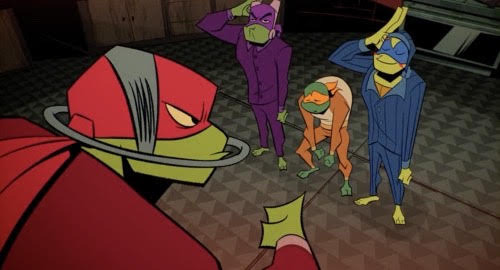
Donnie teasing his brothers and hitting them with the tennis balls all smug in Smart Lair feels very Leo of him
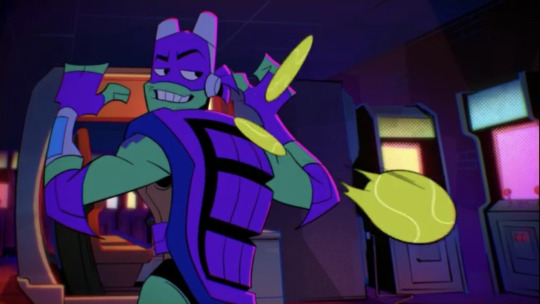

Leo being the naysayer of the group in The Gumbus and constantly insisting there has to be some kind of logical/scientific explanation is very Donnie of him
“There has to be a simple answer. Earthquake, magnets, giant prankster mice. There’s no such thing as ghosts!” “A model train. Simple answer.” “Aha! Right? The simple answer!”
Donnie has a funny line about Dragons (and their teeth) not existing, both these moments being ironic since discovering yokai, the Hidden City and the whole mystics world makes dragons and ghosts not just possible, but proven real
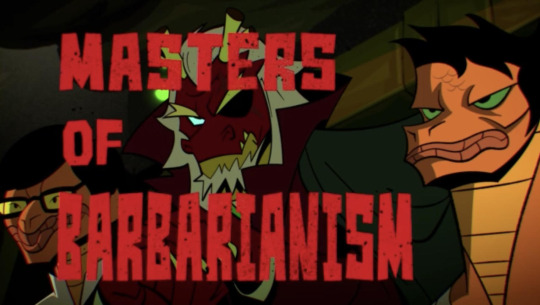
Their iconic weird showing-off-clothes poses in Purple Jacket and Late Fee
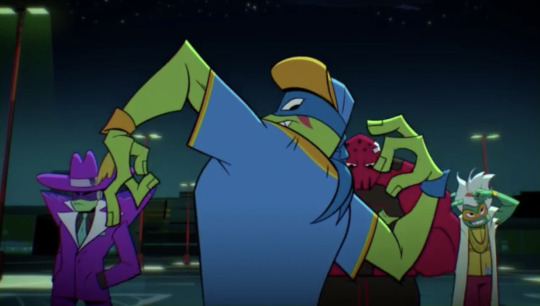
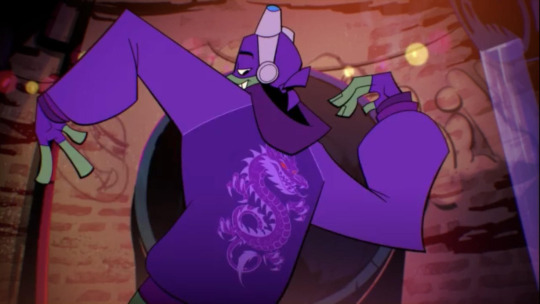
These lines:
“Can’t we get new brothers?!”
“We have to go back for our brothers! Or are you gonna replace them, too?!”
“Guh-ee…”

They are also the only two characters with lines mentioning they think Splinter would’ve been cooler specifically as a tiger 😂 While I love the Eric Bauza/Tigerclaw references to ‘12, otherwise the comments are rather random other than saying tigers are cooler than rats. It made me realize how much they really do think alike. “You’re just a rat, we need a tiger.” “Yeah sure you’re a rat and it probably would’ve been cooler if you were like a tiger or something.”
More similar lines when they both break the fourth wall: “One season later and I still have full battery!” “If this isn’t the poster shot, someone’s getting fired.”
Leo’s chosen last words: “With my last breath I told you sooooo!”
Donnie’s chosen last words: “At least I shall perish knowing I was the better brother.” (a lie)
I believe they’re also the only ones to call Splinter Papa whereas Raph and Mikey use ‘Pops’ more
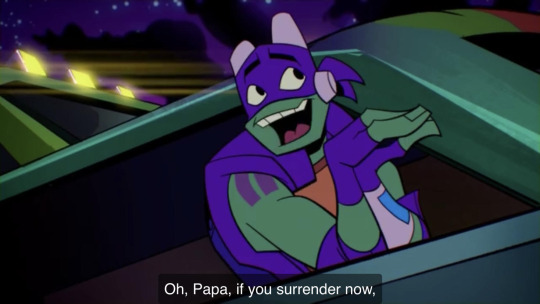
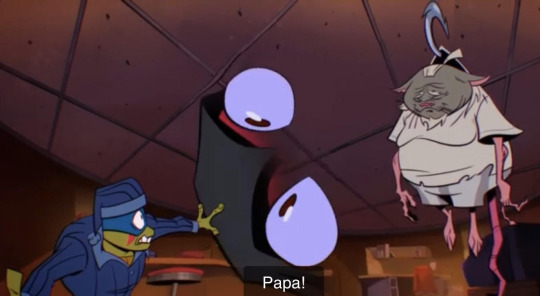
And last but not least, their shared aversion to Staten Island
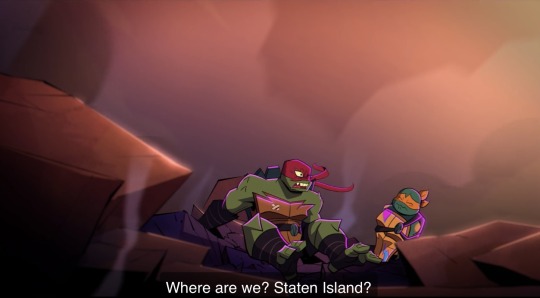


Bottom line, the rottmnt writers practically made their twinship canon without realizing it sooo it’s pretty much undeniable now 😊
#disaster twins#rottmnt#rottmnt leo#rottmnt donnie#rottmnt disaster twins#tmnt#ninja turtles#save rottmnt#unpause rottmnt
699 notes
·
View notes
Note
Having recently read The Blue Castle for the first time, I'm fascinated by your idea of a dystopian retelling! Would you be willing to share more about it?
I shared the plot summary as an Imaginary Book Rec, but since I'm not going to give in to the impulse of writing this story at the moment, I may as well jot down the other details I have.
Valancy lives in a society that's completely ruled by AI (or, at least, AI overseen by humans who totally buy in to this program). There's large-scale AI that controls wider societal functions, but every household is also ruled by a Motherboard that watches every move they make and micromanages their schedule down to the minute.
It's believed that strict adherence to these rules will keep society efficient and safe. Any deviance is strictly punished.
This society views itself as the last bastion of civilization in a post-apocalyptic world. After the disasters that destroyed civilization, this society arose to provide perfect safety and security. Its citizens believe that the world outside the city walls is a dangerous, toxic wasteland, full of beasts and bandits and disease, and that banishment from the city is a death sentence.
(This society calls itself Sterling because they're aiming for perfection after the mistakes of the past).
Imagination and art are deemed useless. Every minute must be spent in some useful activity.
Valancy is a cog in the machine. The AI has labeled her as having no special potential, so she works at repetitive manual labor--I'm thinking janitorial work--and has not been allowed to be paired for reproduction. (I'm thinking the society allows arranged pairs to meet and reproduce, but all children are taken from families and raised in groups, possibly by robots)
Valancy is outwardly a perfect citizen, but internally, she has a rich inner life, and survives by imagining a more romantic world.
The works of John Foster are a major inspiration. The Motherboard deems them acceptable reading, since they're scientific texts about the state of the natural world before the apocalypse, but the AI analysis can't see the human emotion that goes into these works, and how Foster subtly inspires his readers to want more than their perfectly organized society.
(I envision an early scene where Valancy wants to read. The Motherboard protests that this is unacceptable, because she wasted 17.24 minutes in idleness yesterday, but relents when Valancy points out it's a useful scientific text.)
When Valancy starts having heart trouble, she gets analyzed by the infallible medical software, which coldly informs her that she has a year to live and is not worth saving. This is Valancy's breaking point--she's not going to live her last year under the Sterling restrictions.
She starts doing shocking things like expressing emotion, making jokes, and deviating from her schedule. The family dinner scene is replaced by an incident where she displays some of these rebellious behaviors at dinnertime in front of her fellow assigned house-mates, who all think she's gone crazy.
She meets Cissy, who has been cast aside by the Sterling society. She committed the crime of engaging in sex outside of AI-approved encounters, so she's no longer part of proper society. She's not banished to the Wilderness, but she's not allowed medical care, no one's supposed to interact with her, she has no job/food/housing and has to scrounge where she can. Valancy decides to help her out.
Valancy meets Barney Snaith a couple of times. He was banished to the Wilderness but gets to come to the gate sometimes for reasons (maybe Sterling City gets some resources from outside its walls?). There are tons of rumors about the crimes he committed that got him banished.
Eventually, Valancy's work with Cissy gets her (maybe both of them?) banished to the Wilderness. Barney helps Valancy to give Cissy a proper burial in the woods. He then recognizes that Valancy won't be able to survive on her own, and offers her shelter at his place. (I don't think they necessarily need to marry in this scenario. But of course they fall in love over the course of the story).
Valancy learns that the Wilderness, while dangerous, is also full of wild beauty. Barney helps her learn to survive in it and to love it.
Barney's got some major secrets--he'll go off sometimes for mysterious purposes and he refuses to let Valancy come with.
Valancy eventually learns that Barney's part of a rebellion to take down the Sterling society. His father leads the rebellion (he accidentally invented some technology that can take down the AI). Barney used to be a bigger part of it until he was betrayed by a woman he loved and banished to the Wilderness. After nursing his wounds for a while, Barney decided to help the rebellion in a different way, with his writings as John Foster.
But by the end of the story, Barney's father comes back in the picture, and Valancy learns she's not actually dying so she doesn't need to be protected from the stress of the rebellion, and she and Barney join the rebellion in a more active way, helping to take down the Sterling society and put the new government in power.
Making this AU helped me to realize that The Blue Castle already is a dystopian story--all about rebelling against an oppressive society--so putting it in this genre is a really natural fit.
34 notes
·
View notes
Text
Fish of the Day
Today's fish of the day is the giant oarfish!

The giant oarfish, scientific name Regalecus glesne, is one of the three surviving oarfish alive today, and the most notable. Oarfish are primarily known for much of the mystery and myth surrounding them, along with their long and irregular shape. Oarfish are the longest bony fish alive, and can grow upwards of 8 meters long, and are believed in Japanese mythology to warn or signify oncoming earthquakes and natural disasters, portraying them as harbingers of doom. There are also conspiracy theories online in spaces dedicated to expressing fear of the ocean that claim that the oarfish which have been observed are only juveniles, and that in deeper waters there may be larger oarfish. Which is untrue, as adult and sexually mature oarfish have been observed.

Giant oarfish in particular can be found from as far north as 72°N and as far as 52°S South, but mostly can be found in the tropics, middle latitudes, and around the eqator.It can be found in the Pacific, Atlantic, and Indian oceans, traveling between them following food. This fish lives in both the Epipelagic and mesopelagic zones, thought to be from around sea surface to 1000 meters below surface. although the deepest actually recorded record of giant oarfish is only 492 meters in the Gulf of Mexico. This fish, despite missing and or having significantly reduced pectoral, caudal, and anal fins along with no swim bladder, swims thought undulation of the dorsal fin, often in a vertical position, giving rise to theories that this fish in particular may have been the origin of sightings of "sea serpents" from the depths. This is particularly evident when storm or natural disasters are approaching, as they tend to be found beached before and after large storms.

We know very little about the diet of this fish, as almost all living fish captured have empty stomachs or simply colored liquids inside, although some have had krill inside. Regardless of what the diet is made up of, it supports these fish's ability to get upwards of 7-8 meters, with the longest recorded being an entire 26 feet in length. As far as we are aware the giant oarfish has no natural predators, although these fish have been known to self amputate, removing entire meters of their bodies at a time.The organs of the giant oarfish, and oarfish in general are clustered close to the head of the body, with the reminder being made up only of the caudal fin and vertebrae, making it easy for this fish to self amputate without the removal of any organs. This is for reasons we do not currently understand.

The only species of oarfish of which the reproduction is well understood and the model understanding for other species is the giant oarfish. That being that these fish are solitary, meeting only for breeding and spawning. These fish spawn from July to December, breeding for only two months or so individually before leaving the group to return to solitary life. These fish will release eggs and sperm, having multiple breeding events a season after which they abandon the eggs to the water column. These eggs are zooplankton, carried by the currents for around 3 weeks until they hatch and can swim. Very little is known about their lifespan and growth rate, but juveniles spawn with full pelvic fins and a long dorsal fin spanning much of the vertebrae, and that this pelvic fin grows smaller in comparison to the rest of the body as they age.

That's all we know about the giant oarfish, and oarfish in general for now! Have a wonderful rest of your day!
#fish#fish of the day#fishblr#fishposting#aquatic biology#marine biology#freshwater#freshwater fish#animal facts#animal#animals#fishes#informative#education#aquatic#aquatic life#nature#river#ocean#oarfish#giant oarfish#Regalecus glesne
48 notes
·
View notes
Text
Design for wing saber , mugen , ichibi and hyakurai the caliber minicon team
Assasins for the functionist council that belived in prima's cause, they aided in the revolution that created the autobots and decepticons and gave up their lives to create powerlinxing, bringing the transformers closer together, neither wing saber nor his minicons can naturally fly on their own but when united they can soar together
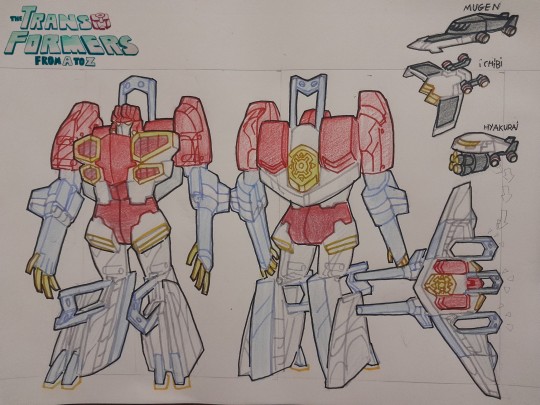

During the functionist era, cybertron was rulled by a functionist council of rich and powerful transformers that acted out of the city of iacon. To enforce their rule over the planet they had assassins and soldiers built to be bigger, stronger, more alive, and as their projects grew in scope the material left for cybertronians to build regular people out of shrunk, which led to a minicon population boom
Already dissatisfied with the state of the planet many people decided to leave and settle elsewhere, facilitated by the fact they don't need to breathe cybertronians were able to create a permanent settlement on one of cybertron's moons even though their technology in this era was similar to what we on earth have today
Wing Saber was built as an assassin for the functionist council, but he was a flawed weapon. always compassionate to the downtrodden and oppressed, he would fail many of his tasks, only able to work well enough to be kept around, but that's because he masks his true potential
Because such a thing is impossible to measure comprehensively, he doesn't know, but wing saber is the greastest swordsman in the entire universe, this ability coming from his conection to his minicons, the first to coin the oddly spelt term "powerlinxing"
The four of them are the first followers of prima, and after a betrayal left the early leaders of the revolution banished to the planet dominus, they worked together with the native nebulans of the world, to sacrifice themselves granting prima the power of the star saber
The caliber minicon team are brought together by their connection to wing saber which turned romantic at some point before they met prima but they each have their own background
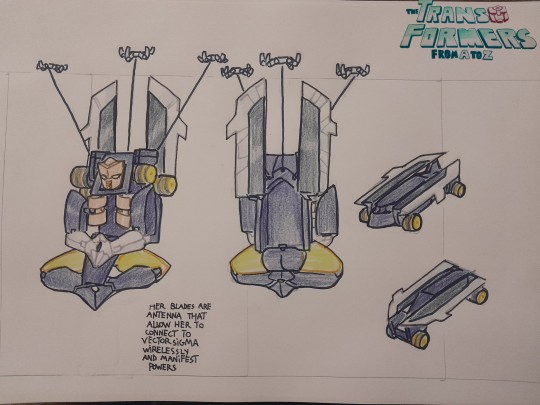
Born and raised on the religious temple of the torchbearers on one of cybertron's moons, Mugen came down to cybertron during the functionist era to spread word of the enigma of combination only to find herself engaged with the social struggles on the planet Mugen was a mystic who believed in prophecy and magic, and it was her powers amplified by her partners, combined with the nebulan's technology that allows powermasters, headmasters, and target masters to come about through the creation of the dominus system and the masterforce that allows transformers to merge with and upgrade technology foreign to them.
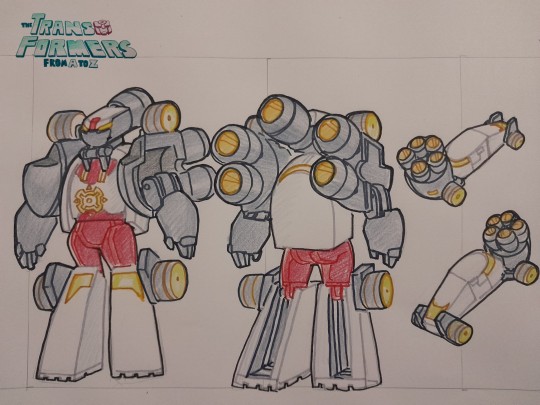
A serious and scientific bot, hyakurai saw the fight for rights and freedom of his era through a logical analytic view, reasoning that the system was inefficient and the ideologies it's founded on misinformed, and that's why it must be torn down Wing saber and mugen had something of a savior complex, and hyakurai worked hard to make sure they didn't put their noses where they don't belong. The care he showed for them was reciprocated, and the relationship between the three of them turned romantic,
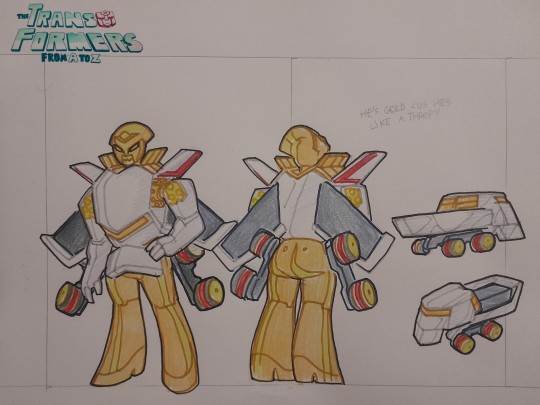
A master of misdirection, ichibi was a fellow assasin of wingsaber, and his closest friend, ichibi loves playing with emotions and getting reactions out of people, his flirting with disloyalty being what gets wing saber to consider intentionally failing at his job, Ichibi is not part of the little relationship between the other three. Although they wish he was, he liked being a tease and was genuinely friends with all three of them enough to live together, but for some reason or another, this setup just seemed more interesting to him

The caliber minicon team was entombed in the disaster planet dominus within a star harvester that their bodies modify to broadcast the masterforce throughout the dominus system, bouncing the energies to cybertron's moons and back to dominus creating a triangle of space where the transformers are empowered,
Their bodies have been crushed into a black disk that slots into the star harvester called the black star matrix, it's power creating the titan fortress maximus and his brother grand maximus.
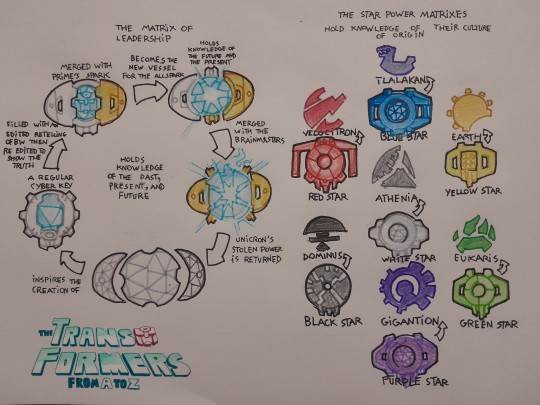


#transformers#transformers fanart#cybertronian#robot#robots#character design#autobots#maccadams#maccadam#wing saber#transformers energon#transformers unicron trilogy#transformers au#transformers designs#transformers from a to z#caliber minicon team#minicons
29 notes
·
View notes